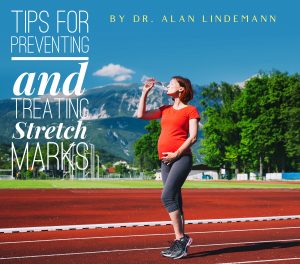Tips for Preventing and Treating Stretch Marks

Tips for Preventing and Treating Stretch Marks
By Dr. Alan Lindemann
Pregnancy is a beautiful time when you are preparing to bring a new life into the world. But stretch marks can still be a nuisance.
As an obstetrician and maternal mortality expert, I’ve delivered more than 6,000 babies over nearly 40 years. Women often ask me if there’s anything they can do to prevent or treat stretch marks.
Stretch marks (long thin scars) are created when your skin is stretched a great deal over a short period of time, such as during pregnancy. The stretching causes the collagen and elastin in your skin to rupture. The scars appear as your skin heals. When they first appear, stretch marks tend to be red, dark brown, reddish-brown, purple, or pink, and may feel slightly raised. Over time, the color should fade, and the scars sink beneath your skin.
Although stretch marks are annoying, they don’t have any health implications. You just might not like the way they look. Although there’s no proven way that you can prevent stretch marks (or make them disappear), there are some things that you can do to lessen the chances that you’ll get them, and to diminish their appearance.
For instance, the thin or thick nature of your skin comes with genetic makeup, so that is beyond your control. If your mother had stretch marks, there’s a better chance that you will, too. There are some preventative measures you can take, though. The one thing that I have found to be helpful in the prevention of stretch marks is exercise. Physical fitness is your best bet for keeping stretch marks at bay.
By starting pregnancy at an appropriate weight and fitness level, you can help prevent stretch marks. The exercise will help distribute the size of the uterus, rather than have it hanging out front. If you’re still in the pregnancy planning stage, now is a great time to start working out.
If you’ve already developed stretch marks, treating them may be challenging, but not impossible.
Instead of investing in expensive creams, I always suggest going back to exercise after the baby is born. Vitamin E and coconut butter are popular traditional treatments, but they are not a substitute for the great circulation and taut skin that exercise and nutrition provide. It’s also important to keep yourself hydrated by drinking lots of water. Whatever exercise you were doing before pregnancy, continue that routine while you are pregnant.
Exercise is important, but I don’t recommend diving into a new physical activity during pregnancy in order to prevent stretch marks. Just continue doing what was already a part of your routine.
The truth is that some stretch marks may be inevitable. However, staying healthy during your pregnancy is much more important than preventing these superficial (and harmless) marks. Staying physically active and hydrated during and after pregnancy are your best bets for keeping them at bay.
ABOUT THE AUTHOR:

An obstetrician and maternal mortality expert, “Rural Doc” Alan Lindemann, M.D. teaches women and their families how to create the outcomes they want for their own personal health and pregnancy. A former Clinical Assistant Professor at the University of North Dakota, he is currently a clinical faculty member available to serve as preceptor with medical students in rural rotations. In his nearly 40 years of practice, he has delivered around 6,000 babies and achieved a maternal mortality rate of zero! Learn more at LindemannMD.com.
Disclaimer: The views and opinions expressed in this article are those of the authors and do not (necessarily) reflect the views of PregnancyJournal.com. PregnancyJournal.com can in no way whatsoever be held responsible for the content of such views nor can it be held liable for any direct or indirect damage that may arise from such views.




